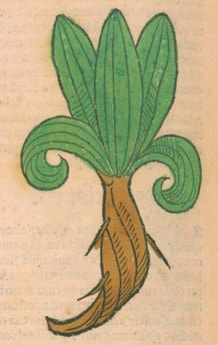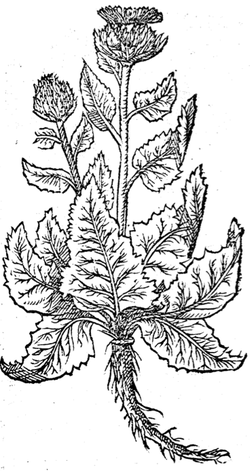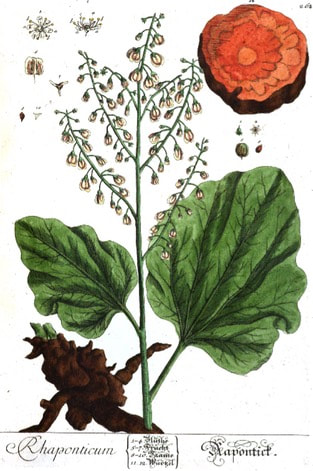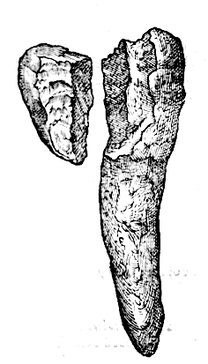Rhei Pontici Rapontici, Pontic Rhubarb or Rhaponticum
English Rhubarb
Ortus Sanitatis, Meydenbach, 1491
The Root, from Gerards Herbal, 1636
Botanical name:
Rheum rhaponticum
Parts used:
Root
Temperature & Taste:
Cool (some said Neutral), dry. Sweet, Pungent, Bitter
Rheum rhaponticum
Parts used:
Root
Temperature & Taste:
Cool (some said Neutral), dry. Sweet, Pungent, Bitter
Uses:
1. Clears Heat and Poison, Purges:
-Purges Choler (Bile), Phlegm and Melancholy from the Stomach and Bowels:
-Stomach Fever
-Diarrhea, Dysentery
-excellent for obstruction of the Mesenteric
-skin diseases from Heat; Scabs, Itch
2. Opens Obstructions:
-opens the Spleen; used for Melancholy
-opens the Liver; Jaundice
-Hernias
3. Moves the Blood, Promotes Menstruation:
-promotes Menstruation, Chlorosis
-Bruising, congealed Blood
-also for Uterine Bleeding
Comment:
Rhaponticum is generally used as Rhubarb, but is milder in effect. Its primary use is as an alterative, to clear Heat and Poison.
Dose:
Powder: 1½–5 grams (traditionally ½–1 ½ drams)
Infusion or Decoction: 3–9 grams (traditionally 2 drams–½ oz.)
Rhaponticum is generally used as Rhubarb, but is milder in effect. Its primary use is as an alterative, to clear Heat and Poison.
Dose:
Powder: 1½–5 grams (traditionally ½–1 ½ drams)
Infusion or Decoction: 3–9 grams (traditionally 2 drams–½ oz.)
Main Combinations:
1. Trauma, Bruising (Vulnerary Decoction):
i. Pontic Rhubarb with Saxifrage, Ladies Mantle, Agrimony, Bugle, Comfrey, St. Johns wort, Plantain, Nettle, Tormentil (Dispensatorium medico pharmaceuticum Palatinatus, 1764)
ii. Pontic Rhubarb with Amber, Madder, Comfrey, Myrrh, Frankincense
2. Pain from Blood Stagnation, Rhapontic with Agrimony, Indian Spikenard, Cassia wood, Costus, Licorice, Asarum, Clove, Saffron (as in Antidotum Immortale)
3. Liver hardness, Rhapontic with Scarlet pimpernel, Indian Spikenard, Mace, Asarum, Agnus Castus
Major Formulas
Powder for Bruises (Lemery)
Troches Proven for Hardness of the Liver (Nicolas)
Diacameron Minus (Nicholas)
Antidotum Immortale
Cautions:
It was recognised as being safe for use in Pregnant women, although full doses should be avoided.
Main Preparations used:
It was recognised as being safe for use in Pregnant women, although full doses should be avoided.
Main Preparations used:




